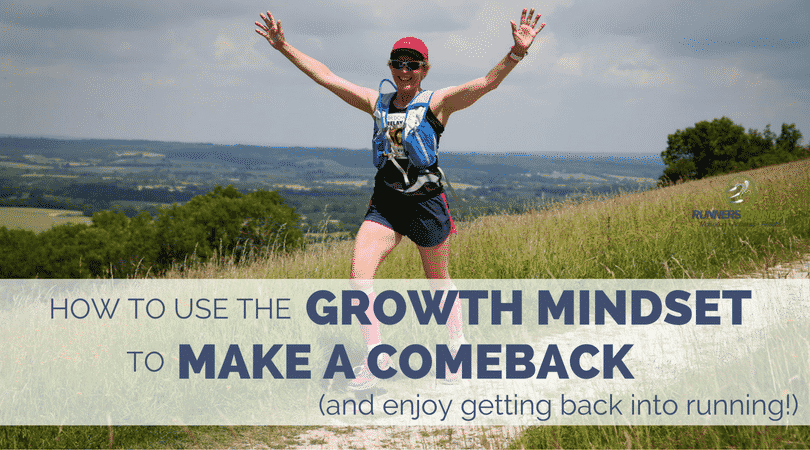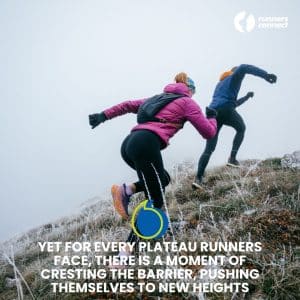Getting back into running after years off can bring physical, mental, and emotional struggles.
Regardless of whether you are returning to running after an injury, you lost your passion for running, or life just got in the way, getting back into running shape after a break is tough, and getting back into running after weight gain can make it even more difficult.
That is why today we are going to share an inspiring story with you about how to return to running after a long break. We will then show you how to get back into running using the growth mindset to make a strong comeback even if your fastest running days are behind you.
You may remember Sarah Russell from this episode of the Run to the Top Podcast, but in case you missed it, her story will show you how to get back into running, even if you are not quite ready yet.
Or so you think…

Six years ago I was training for an Ironman triathlon.
I was the fittest I’d ever been and well on track for a great race.
Then in the middle of the night out of nowhere, I developed agonizing abdominal pain.
My husband rushed me to hospital and I was admitted for emergency surgery at 1am.
I remember lying in the ER saying to the Doctors (in a morphine induced haze)
‘But I’m doing an Ironman in 8 weeks? I’ll be ok by then right?’
Of course it never did happen.
It turned out I had a perforated colon, life-threatening peritonitis and I had to have part of my bowel removed and be given a colostomy bag (technically I have an ileostomy which is made from the small intestine).
Over the following 18 months I was in and out of hospital and underwent 5 major abdominal surgeries to deal with various complications.
It was utterly miserable and if someone had put a gun in my hand I’d have been tempted to use it.
I was frail and weak and my muscles had wasted away.
I couldn’t eat solid food for months and existed on boiled sweets and milkshake; running was the last thing on my mind.
Having an ileostomy itself wasn’t really the biggest problem either. Eating is such a basic function. It sustains life on the most basic level… yet it is also a source of pleasure, social interaction, celebration and enjoyment.
When that is taken away it changes your life in every possible way.
Getting Back into Running After Years Off
Eventually I had a successful operation in 2012 and I started to get stronger and healthier again.
I still had my ileostomy, but I was able to eat and started to train again.
It was a far cry from where I’d been, but I could shuffle around the trails and started thinking about aiming for some events.
And this is where the story gets interesting.
No motivation to run
Prior to getting ill, I’d been really competitive and driven.
Initially I wanted to ‘get back’ to that, to pick up where I’d left off, maybe train for that Ironman again.
But very quickly I found that my drive had deserted me.
It was almost as if my body had developed a built-in control switch. I did a couple of events but didn’t really enjoy them. Being so much slower in the same race I’d previously done well in was demoralising and depressing.
Make Running Fun Again by Embracing New Challenges
Gradually I found that I was happier just trotting about the trails, taking in the view and being grateful that I could just eat and move.
My perspective had shifted on its axis and I had to go with the flow and embrace it. I found I had so much more gratitude and appreciation for the most basic things.
Race times and training splits meant nothing anymore.
In their place I found I was more interested in the scenery, having an adventure and enjoying the beauty of the world and people around me.
And so I found myself searching out events that just ‘meant more’. Events that would give me a sense of awe, provide me with adventure and a life affirming experience.
Within 9 months of surgery I took part in the Jungfrau Marathon in Switzerland.
It finishes high up in the mountains close to the summit of the Eiger and is one of the most beautiful races in the world.
It was overwhelmingly emotional and I cried the whole race, simply because it was so beautiful.
It was my slowest marathon to date, but I didn’t care. I ran with my hubby and we finished hand in hand over the finish line.
After everything I’d endured, to be able to complete such a tough and beautiful race was the single most incredible moment of my life.
Planning ahead for new challenges
Then a year later I found myself on a flight to Delhi to take part in a race that had been on my radar for over 10 years.
The Himalayan 100 is a 5-day stage running event high up in the mountains of the Indian Himalaya, covering 100 miles at altitude.
If you want a life affirming experience the Himalayan 100 is it.
At one point in the race, runners are treated to the sight of the peaks of four of the five highest mountains in the world.
Taking part in an event like that with an ileostomy posed a number of challenges, but hydration was my biggest concern.
With my ileostomy I lose approximately 1000ml of fluid a day more than a normal person.
This can cause dehydration very quickly and when you add long distance running, high temperatures and altitude to the mix, it became a high-risk proposal.
But with a careful hydration strategy and litres of electrolyte replacement each day, I managed to stay on top of it and was absolutely fine.
The event was grueling and tough, but at the end when it was over I felt invincible.
It was incredibly empowering.
I crossed the finish line and thought ‘If I can survive five major abdominal surgeries and then run 100 miles at altitude with an ileostomy in the Himalayas, I can do anything’.
And that’s what running does for anyone. It empowers you and makes you feel invincible. It’s about overcoming barriers and obstacles and that’s what builds confidence, self-esteem and affirmation.
Conquer your first marathon or ultra and you feel superhuman.
Running really does change your life.
The more challenges you have to face to get there; the sweeter the achievement.
When I ran in the Himalayas, I got to witness the stunning sight of Mt Everest at dawn, with the first glimmers of light shining on the World’s highest peak. It was breathtaking – spine tingling stuff.
Richard Nixon once said ‘Only if you have been in the deepest valley, can you truly appreciate the magnificence of the highest mountain’.
I often wonder if I’d have enjoyed it so much if I’d not experienced the ‘deepest valley’. I doubt it.
How to Regain Confidence Using the Growth Mindset
I’ve read a lot about a concept called the Growth Mindset, and this has become key in helping me cope with my ileostomy and managing the set backs and obstacles that come with it.
The Growth Mindset is a concept developed by Carol Dweck – a professor of psychology from Stanford University.
The growth mindset is a very simple – yet incredibly effective – approach, which can help us in all areas of our lives, and especially in running and when faced with challenges, illness and injury.
Having a growth mindset is about being flexible, resourceful, resilient and finding solutions to problems.
It’s much more than just ‘being positive’ or mentally tough.
It’s about being solution orientated and having the right mindset to help us overcome obstacles and reach our goals.
It’s about getting back up when you’ve been knocked down a hundred times.
Where running is concerned, someone in the fixed mindset (which is the opposite) might say:
‘I’m injured.. I can’t run, I’m devastated’ and sink into depression, negativity and give up.
However a runner using the growth mindset might say:
‘I’m injured… ok this isn’t great, but what else can I do? What cross training is best for me and my injury? What rehab exercises can I be doing whilst I heal and recover?’
See the difference?
Why the growth mindset works for runners
It’s not just about being positive.
It’s about finding a way around a problem.
It’s about seeing a challenge in a different light and developing solutions and resourcefulness.
Having a growth mindset builds ‘grit’, resilience and self-efficacy.
The more challenges you overcome, the more confident you become in your abilities.
And the good thing about it is that just by knowing about the growth mindset, you can start to change how you think.
For me, it would have been easy to give up, to say ‘I have a colostomy bag now, I can’t run anymore, I can’t go to the Himalayas, or take part in that race’.
But I’ve found the growth mindset to be a powerful tool to help me overcome the challenge of living with an ileostomy and enable me to live my life to the fullest.
Adversity and challenge teaches us so much.
It makes us stronger and shouldn’t be feared.
For me my colostomy bag is simply a challenge to overcome – much like a marathon or any other race.
It’s not a barrier, nor is it a disability and I’m not about to let it stop me doing anything.
I’m not the athlete I once was, but I’m on another path now and I’m 100% ok with that.
Being able to see amazingly beautiful mountains, share my run with people I love, take part in epic events and have some incredible life affirming experiences, that’s what matters now.
—
Inspired?
You can listen to the rest of Sarah’s story on the Run to the Top podcast.
RunnersConnect Bonus
Download your FREE Ultra Runners Checklist.
Giving you an easy to follow, printable list of the 9 steps to follow as you prepare for your first (and every) ultra marathon.




